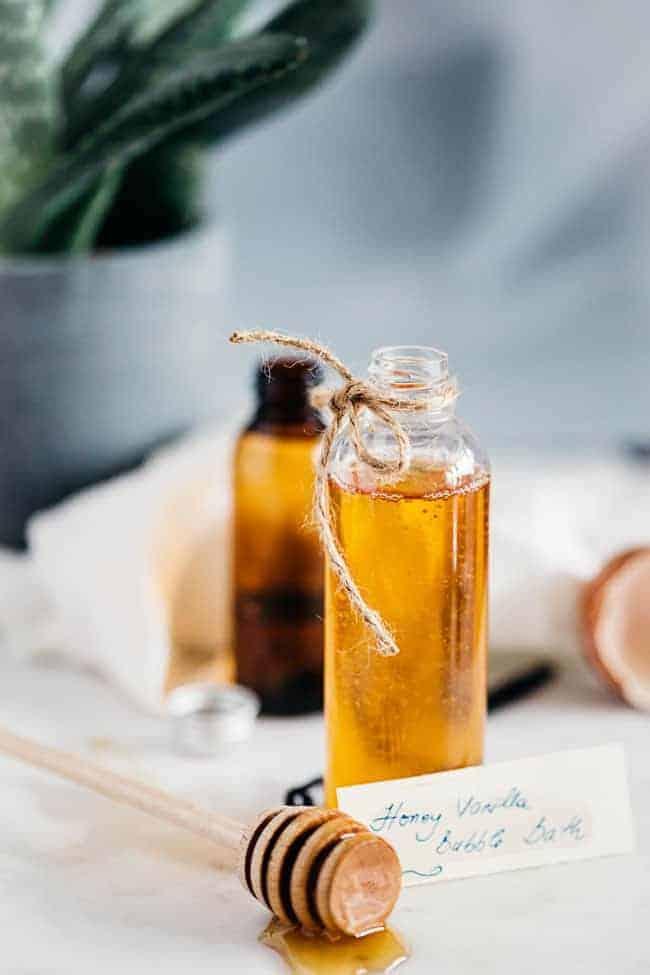One of the best things you can do is indulge in some relaxation, and an easy way to do that is with a hot bubble bath. If you're feeling crafty, it's really easy to DIY your own bubble bath solution with some household ingredients.
The beauty of creating your own bubble bath is knowing exactly what you're putting in your bathtub and on your body, and you get the added satisfaction of knowing you made it yourself. If this sounds like your ideal cozy night in, here's what you need to know before soaking and a few expert-approved DIY bubble bath recipes to try.
RELATED: How to Make a DIY Bath Bomb Without the Harmful Chemicals
In Janice Cox's book Natural Beauty at Home, she recommends this bubble bath recipe: take a clean container, mix 1/2 cup mild liquid hand or body soap, 1 tablespoon sugar or honey, and one egg white. Then pour the entire mixture under the running water as you draw your bath.
Honey is a natural humectant, which will attract and retain moisture in your skin. The egg white helps create stronger, longer-lasting bubbles, for a nice, fluffy bath. For extra-dry skin, consider adding a tablespoon of light oil, such as almond oil, for extra nourishment.
Mix equal parts water and Dr. Bronner's Unscented Pure-Castile Liquid Soap, then add in black sea salt to your desired consistency. You want to use enough for it to give you a fizzy bath so the black sea salt can moisturize dry skin, so keep going until you start to see bubbles.
Make your bubble bath extra sweet with this DIY recipe of Cox's: In a clean container, mix 1 cup of light oil (almond, sunflower, or canola), 1/2 cup honey, 1/2 cup mild liquid hand or body soap, and 1 tablespoon vanilla extract.

Start with gentle liquid soap, like Dr. Bronner's Unscented Pure-Castile Liquid soap, then add in two to three drops of lavender essential oil. Stir in 1 tablespoon of coconut oil until blended and dilute the solution with enough water to thin it out. It's as easy as one, two, three!
Keep things simple by mixing 1 cup of warm water with 1 cup of Dr. Bronner's Unscented Pure-Castile Liquid soap. Then, add 1 tablespoon of coconut or almond oil, 1 teaspoon of epsom salt, and two to three drops of your favorite, non-irritating, essential oil.
RELATED: Does Aromatherapy Just Smell Good—or Does it Have Actual Health Benefits?
Now that you have a few recipes up your sleeve, here are a few more things you should consider for the perfect bathtime experience.
If you share your tub with someone, you may not know what products were in there beforehand, which means the tub could be slippery or have an irritating product lingering behind. Therefore, Elizabeth Trattner, AP, LAc, DiplAc, NCCAOM, a doctor of Chinese and integrative medicine, recommends cleaning your tub immediately after using it to prevent stains and suggests checking before starting your bath to make sure it's sanitary.
Unless you have extremely sensitive skin, adding a bit of essential oil to your bubble bath solution can increase your relaxation. Essential oils, such as lavender and chamomile, can help you relax after a stressful day, whereas an oil like sandalwood can help moisturize dry skin.
Just take caution with how much essential oil you're adding to the mix to prevent skin irritation. To play it safe, use no more than a couple of drops in your bubble bath solution and only use essential oils you know won't irritate your skin. If you're unsure, avoid them to play it safe, says Sarah Biggers-Stewart, founder and CEO of vegan cosmetics brand CLOVE + HALLOW.
Biggers-Stewart advises anyone who wants to make their own bubble bath to absolutely avoid sodium lauryl sulfate, a common binding agent that's used in cosmetics and skincare products to hold oil and water together. "SLS (sodium lauryl sulfate) is a very common surfactant in products that creates foam and bubbles," she says. However, she warns that it can be irritating for sensitive skin types and recommends against soaking in it for a prolonged time.
Studies have proved how irritating SLS can be on the skin, especially in warm water as the heat can increase the potency of any product you put in it. Trattner adds that it's bioaccumulative, which means it stays in your body. "Hot water will drive these into the body faster as pores are open, and they can cause dermatitis as well," she says.
When it comes to making a bubble bath at home, it may actually be difficult to create lots of bubbles as lighter materials tend to not lather as much as a store-bought solution. "It would be hard to make a super fizzy bubble bath at home, but for a more subtle bubble bath, a combination of castile soap, some essential oils, and a little bit of olive or coconut oil would do the trick," says Biggers-Stewart.
There's something very romantic about bathing with floating flower petals, but it's one of those additions that's good in theory and bad in practice. "Flower baths make a mess," says Trattner. "You can always make a flower tea, but you will have to scrub the tub." Plus, flower petals aren't doing anything for your skin, so you may as well leave them out.